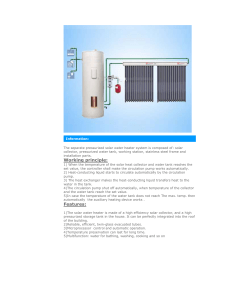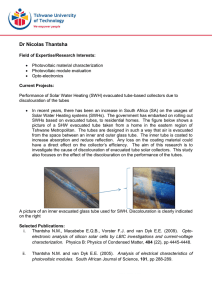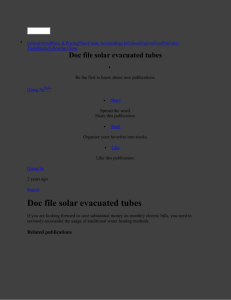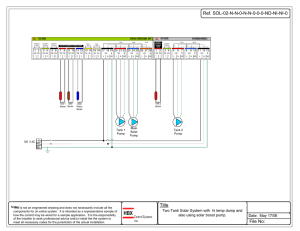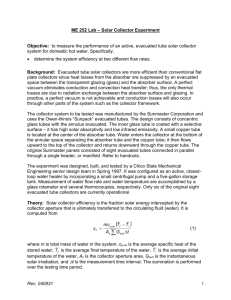IRJET- Enhancement of Heat Transfer in Solar Evacuated Water Heater using Al2O3 Nanofluid
advertisement
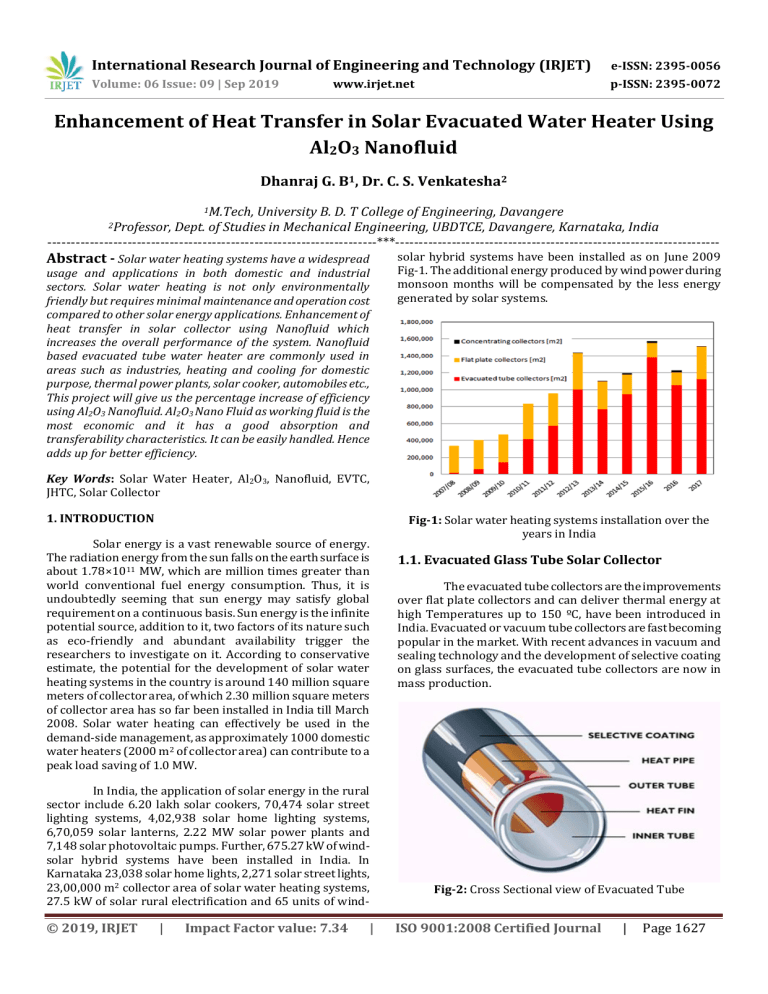
International Research Journal of Engineering and Technology (IRJET) e-ISSN: 2395-0056 Volume: 06 Issue: 09 | Sep 2019 p-ISSN: 2395-0072 www.irjet.net Enhancement of Heat Transfer in Solar Evacuated Water Heater Using Al2O3 Nanofluid Dhanraj G. B1, Dr. C. S. Venkatesha2 1M.Tech, University B. D. T College of Engineering, Davangere Dept. of Studies in Mechanical Engineering, UBDTCE, Davangere, Karnataka, India ----------------------------------------------------------------------***--------------------------------------------------------------------2Professor, Abstract - Solar water heating systems have a widespread usage and applications in both domestic and industrial sectors. Solar water heating is not only environmentally friendly but requires minimal maintenance and operation cost compared to other solar energy applications. Enhancement of heat transfer in solar collector using Nanofluid which increases the overall performance of the system. Nanofluid based evacuated tube water heater are commonly used in areas such as industries, heating and cooling for domestic purpose, thermal power plants, solar cooker, automobiles etc., This project will give us the percentage increase of efficiency using Al2O3 Nanofluid. Al2O3 Nano Fluid as working fluid is the most economic and it has a good absorption and transferability characteristics. It can be easily handled. Hence adds up for better efficiency. solar hybrid systems have been installed as on June 2009 Fig-1. The additional energy produced by wind power during monsoon months will be compensated by the less energy generated by solar systems. Key Words: Solar Water Heater, Al2O3, Nanofluid, EVTC, JHTC, Solar Collector 1. INTRODUCTION Solar energy is a vast renewable source of energy. The radiation energy from the sun falls on the earth surface is about 1.78×1011 MW, which are million times greater than world conventional fuel energy consumption. Thus, it is undoubtedly seeming that sun energy may satisfy global requirement on a continuous basis. Sun energy is the infinite potential source, addition to it, two factors of its nature such as eco-friendly and abundant availability trigger the researchers to investigate on it. According to conservative estimate, the potential for the development of solar water heating systems in the country is around 140 million square meters of collector area, of which 2.30 million square meters of collector area has so far been installed in India till March 2008. Solar water heating can effectively be used in the demand-side management, as approximately 1000 domestic water heaters (2000 m2 of collector area) can contribute to a peak load saving of 1.0 MW. In India, the application of solar energy in the rural sector include 6.20 lakh solar cookers, 70,474 solar street lighting systems, 4,02,938 solar home lighting systems, 6,70,059 solar lanterns, 2.22 MW solar power plants and 7,148 solar photovoltaic pumps. Further, 675.27 kW of windsolar hybrid systems have been installed in India. In Karnataka 23,038 solar home lights, 2,271 solar street lights, 23,00,000 m2 collector area of solar water heating systems, 27.5 kW of solar rural electrification and 65 units of wind- © 2019, IRJET | Impact Factor value: 7.34 | Fig-1: Solar water heating systems installation over the years in India 1.1. Evacuated Glass Tube Solar Collector The evacuated tube collectors are the improvements over flat plate collectors and can deliver thermal energy at high Temperatures up to 150 ºC, have been introduced in India. Evacuated or vacuum tube collectors are fast becoming popular in the market. With recent advances in vacuum and sealing technology and the development of selective coating on glass surfaces, the evacuated tube collectors are now in mass production. Fig-2: Cross Sectional view of Evacuated Tube ISO 9001:2008 Certified Journal | Page 1627 International Research Journal of Engineering and Technology (IRJET) e-ISSN: 2395-0056 Volume: 06 Issue: 09 | Sep 2019 p-ISSN: 2395-0072 www.irjet.net An evacuated tube also calls it as vacuum tube. It efficiently converts solar radiation energy into hot water. An evacuated tube, as shown in Fig-2, consists of inner and outer tube. Inner tube outside surface is coated with black colour and outer tube is made up of high strength impact glass. The annulus between inner and outer tube is completely vacuum. Thus, radiation flow take place from outer to inner but inner to outer is restricted by implementing mirror reflection. The advantages of heat pipe evacuated tubular solar collectors are rapid start-up, anti-freezing, resistance to thermo-shock, resistance to high pressure, easy installation and economical maintenance. come in contact with the outer tank (SS tank) and collector tubes. Here hard water flows in to the inner tank (Copper tank) and gets heated using heat exchanger principle. The outer tank and collector tubes are filled with distilled water which gets heated in the collector tubes due to solar radiation and flows to the outer tank. Due to the Temperature difference between distilled water and hard water heat transfer takes place. Using jacket type heat exchanger which provides a large heat exchanging area and its construction is relatively easy. 1.2. Application of the Nanotechnology into Solar Water Heating Al2O3 Nano powder was selected for its good Thermo-physical properties that were found to be better among the other available Nano powders. In this experiment the samples of 0.4%, volume concentration of Nanofluid is used to prepare Nanofluid using distilled water as base fluid and the Thermo-physical properties of Nanofluid was conducted. The Al2O3 Nano particle used is 99% pure and the composition and properties of Al2O3 Nano particles are shown in Table-1 Solar Collectors are the main features of that have undergone many researches have been the key elements to harness the solar energy. As discussed earlier, solar water heaters, where FPC’s and ETSC’s are used have been operating for more than 4 decades have now been the major applications in this concern. But the water that is used as a working fluid though has many merits, becomes inefficient when it comes for the only station of its thermo-physical properties. It exhibits lower thermal conductivity and cannot attain high rates of heat transfer when used in thermal applications. Freezing and hardness are also the major properties affecting the performance of water. An innovative material- Nano particles have been topping the list of these additives which are performance enhancers when suspended into the conventional heat transfer fluids. The Nano sized particles suspended at a concentration ratio into the base fluid constitutes a Nano fluid. This Nanofluid is an advanced heat transfer fluid which can overcome the limitations in the Thermophysical properties of the conventional base fluids. Many researches have come up in this regard by using many metallic and non- metallic Nano sized compounds. Different nanoparticles like silver, copper oxide, titanium di oxide, alumina, iron oxide etc. have been utilized to their performance along with the conventional fluids. The synthesis and preparation of these Nano sized particles plays an important role which decides the efficiency of the application in which the Nanofluid is subjected to flow. From various literatures available, lots of particles have been tested individually or even mixed with other particles chemically which have yielded positive results in majority when used for heat transfer applications. 2. EXPERIMENTAL PROCEDURE SET UP AND TESTING In this project it is planned to design jacket type heat exchanger tank, here corrosion protection of hard water storage tank and collector tubes, can be achieved by the use of corrosion resistance materials like copper sheet and polymer materials. In this study the hard water does not © 2019, IRJET | Impact Factor value: 7.34 | 2.1. Al2O3 Nanoparticle Characterization Table-1: Chemical Composition of Al2O3 Nanoparticle Test Item Color Particle size Phase type Surface specific area Density Cu Fe K Mn Na Ni S Si Zn Composition White 30-50 nm Alpha 12-18 m2/g 3.9 g/cm3 8 ppm 12 ppm 3 ppm 5 ppm 11 ppm 2 ppm 4 ppm 8 ppm 6 ppm 2.2. Preparation of Al2O3 - Water Nanofluid Based on a vigorous literature survey, the use of Al2O3 Nano particles was selected for this research. Nano fluid was prepared using two step method as presented in Fig-3. In this process, Al2O3 nanoparticles were suspended in distilled water for variable volume concentrations 0.4% by weight. In this preparation, dispersant Sodium Dodecyl Sulphate (SDS), was added to the solution in the weight ratio 1:1 to the nanoparticles. The mixture is dispersed into 1000 ml distilled water (Base fluid). This solution was first stirred in magnetic stirrer for two hours and then vibrated using ultra sonication method for about 8 hours. The obtained Al2O3 Nanofluid sample was analyzed for various Thermophysical properties such as density, specific heat, viscosity ISO 9001:2008 Certified Journal | Page 1628 International Research Journal of Engineering and Technology (IRJET) e-ISSN: 2395-0056 Volume: 06 Issue: 09 | Sep 2019 p-ISSN: 2395-0072 www.irjet.net and thermal conductivity for volume concentrations as mentioned above. The Table-2 shows the specifications of base fluid (water) used in the present nanofluid preparation. The amount of Al2O3 Nanoparticle to be added in the base fluid for different volume fraction is calculated using equation 2.1 as shown below. Fig-4: 2-D model of jacket type heat exchanger tank Specification: Material used Diameter of the tank Thickness of copper sheet Length of the copper tank : Copper : 220 mm : 0.8 mm : 1100 mm 2.5. Experimental Setup of Existing Evacuated Vacuum Tube Collector (EVTC) Fig-3: Nanofluid Preparation Flowchart Experimental setup consists of a tank, vacuum tubes and stand etc., in this setup the tank is placed on the stand and the vacuum tubes are inserted into the tank as shown in the Fig-5. The inlet of the solar water tank is connected with an orifice meter in junction with non-return valve to measure the flow rate of water. The vacuum tubes are place at an angle to receive the radiations from the sun for effective absorption of heat. So, inclination of vacuum tubes plays a vital rule for efficient absorption of radiation as per the reference vacuum tubes are inclinedoat an angle depending on the latitude and longitude of that area. For this project at CPGS VTU Mysuru, Karnataka, India latitude is 130° 24’ 9” and 770° 43’ 49” longitude. Thermocouples are placed at different altitudes one at the top and other at the bottom to measure the mean Temperature of water inside the tank. This makes the complete experimental set up of the normal tank vacuum tube solar water heater. Table-2: Properties of base fluid. Properties Base fluid Density 998.2 Kg/m3 Thermal conductivity 0.599 W/m -K Specific heat 4178 J/Kg -K Viscosity 0.000888385 Ns/m2 2.1 2.3. Design of jacket type heat exchanger tank Material Selection By comparing the proportions of different materials, it has been concluded that the copper will be the best materials for inner tank, because copper has good properties like corrosive resistance, high thermal conductivity (384.3w/m2), good heat absorption and transferability than any other materials. Fig-4 shows the 2-D model of jacket type heat exchanger tank which is made of copper and SS material. Fig-5: 2-D of evacuated tubes Solar Collectors with normal tank © 2019, IRJET | Impact Factor value: 7.34 | ISO 9001:2008 Certified Journal | Page 1629 International Research Journal of Engineering and Technology (IRJET) e-ISSN: 2395-0056 Volume: 06 Issue: 09 | Sep 2019 p-ISSN: 2395-0072 www.irjet.net 2.6. Experimental Setup of Evacuated Vacuum Tube Collector (EVTC) With Jacket Type Heat Exchanger Tank Experimental setup consists of a jacket type heat exchanger tank, make over tank, stand, orifice meter, vacuum tubes, thermocouples etc. as shown in Fig-6. In this jacket type heat exchanger two tanks made up of two dissimilar metals. The inner tank of copper is placed in concentric with the SS-304 outer tank then the jacket type heat exchanger is insulated with PUF (Poly Urethane Foam). PUF is very efficient type of insulation and the next steps of setup are all same as of the normal tank setups. But for the purpose of experimentation 7 thermocouples are placed. One at the inlet of the copper tank and one at the outlet of manifold to the SS304 tank, other two at different altitudes is SS304 tank and as well as two in the copper tank and one more thermocouple to measure the Ambient Temperature. This makes the setup of jacket type heat exchanger. Fig-7: Temperature, Radiation variation with in the tank of conventional evacuated vacuum tube collector and evacuated vacuum tube with JTHE tank v/s time. It is seen from the Fig-7 that the water Temperature in the storage tank increases gradually with time. Radiation gradually increases from morning and reaches the peak value at around 1pm to 2pm due to high solar radiation and angle of incidence is very high during that period and late in the afternoon hours gradually decreases. The outlet Temperature of EVTC with JTHE and conventional EVTC are compared and it is observed that the Temperature in the tanks increases gradually according to solar input and angle. It can also be seen from the graph that the Temperature raise of the water in the conventional water heater is lesser than the designed model and the Temperature reaches to 63.62℃ at the end of the day. Fig-6: 2-D Model of Evacuated Tubes Solar Collectors with Jacket Type Heat Exchanger Tank. 3. RESULTS Two separate experiments were conducted, one on conventional evacuated glass tube collector, second experiment on evacuated glass tube collector with JTHE. The performance of JTHE system was compared with the conventional system with respect to heat rate (Q) and efficiency. Both the systems were carried out simultaneously for the same input irradiance and to check the difference in the results. Fig-8: Variation of Radiation, useful heat rate of conventional evacuated vacuum tube collector and evacuated vacuum tube with JTHE tank v/s Time. It is seen from the figure that the heat input in the storage tank increases gradually with respect to time. It is observed that the average useful energy of JTHE with EVTC is about 70 - 80 W higher than the conventional EVTC. The maximum heat output for the concentric heat exchanger model is 397 W at around 1.30 pm and for the conventional model is around 325 W at the same time. © 2019, IRJET | Impact Factor value: 7.34 | ISO 9001:2008 Certified Journal | Page 1630 International Research Journal of Engineering and Technology (IRJET) e-ISSN: 2395-0056 Volume: 06 Issue: 09 | Sep 2019 p-ISSN: 2395-0072 www.irjet.net Type Heat Exchanger of Evacuated Vacuum Tube Collector and normal Evacuated Vacuum Tube Collector will be maximum. Even in cloudy day maximum Temperature of about 66 – 68oC can be achieved by JTHE of EVTC with minimum radiation. And in comparison, with conventional evacuated glass tube collector’s maximum Temperature of a day over one month will be around 59 - 62℃. The maximum Temperature of about 69 - 72℃ can be achieved by JTHE of EVTC. The minimum temperature is about 67 -69oC. Fig-9: Radiation, Efficiency variation of conventional evacuated vacuum tube collector and evacuated vacuum tube with JTHE tank v/s Time. It is seen that the hourly value measured after 1:00 pm gradually decreases due to low solar input. It is seen from the figure that the efficiency increases gradually with radiation and increases from morning and reaches the peak value at around 1pm to 2 pm due to high solar radiation and angle of incidence is very high during that period and late in the afternoon hours gradually decreases. At the end of the day it is observed that the efficiency of JTHE of EVTC is about 7 - 8% higher than the normal EVTC efficiency. Finally, by taking the maximum Temperature reached in a particular date, a table is prepared consisting of all Temperatures, heat outputs and efficiencies. Calculated results and date basis in the table gives us the complete idea of how the heat output and efficiencies are varying in accordance with the radiation It is evident from the graphs that the jacket type heat exchanger is more efficient and provides a greater heat output due to effective heat transfer. Fig-10: Temperature, Radiation variation with in the tank of conventional evacuated vacuum tube collector and evacuated vacuum tube with JTHE tank v/s Date over a period of one month. Figure shows that radiation from the sun is not constant daily, it varies from day to day and hence the heat input depending on radiation will also vary. Even with the heat input is varying daily, the Temperature rises in Jacket © 2019, IRJET | Impact Factor value: 7.34 | Fig-11: Variation of Radiation, useful heat rate of conventional evacuated vacuum tube collector and evacuated vacuum tube with JTHE tank v/s Date over a period of one month. From Fig-11 it is observed that the heat output will vary depending on the solar radiation over a period of one month. The average heat output of JTHE of EVTC and conventional EVTC is in the range of 400 - 370 W and 290 340 W respectively over a period of one month. From the data recorded it is observed that the performance of JTHE of EVTC is more as compared with conventional EVTC system. Q1 shoes the average heat output of the JTHE, Q2 shows the average heat output of the EVTC and R gives the total irradiance. Fig-12: Radiation, Efficiency variation of conventional evacuated vacuum tube collector and evacuated vacuum tube with JTHE tank v/s Date over a period of one month. ISO 9001:2008 Certified Journal | Page 1631 International Research Journal of Engineering and Technology (IRJET) e-ISSN: 2395-0056 Volume: 06 Issue: 09 | Sep 2019 p-ISSN: 2395-0072 www.irjet.net From Fig-12 it is observed that the efficiency will vary depending on solar radiations and heat output form the system over a period of one month. The average efficiency of JTHE of EVTC and conventional EVTC is in the range of 65 59 % and 56 - 48 % respectively over a period of one month. From graph it is clearly evident that the efficiency of JTHE system is much greater than the conventional EVTC. 5. CONCLUSIONS 1. Copper is used as an inner tank material since the fact that it has a very less fouling factor and salt formation on it is less. Effective heat transfer takes place to the cold hard water inside since the thermal conductivity of copper is high. 2. Outer jacket is made of stainless steel which has better strength properties and provides space for working fluid (distilled water) and transfers the heat to inner tank with minimum heat loss. 3. Poly Urethane Foam (PUF) insulation is the best insulation compared to other insulating materials due to the fact that the close packing cells in the insulation will protect the entire tank setup from the heat loss to the atmosphere and adds to improve the efficiency. 4. 5. Al2O3 Nano Fluid as working fluid is the most economic and it has a good absorption and transferability characteristics. It can be easily handled. Hence adds up for better efficiency. Two experiments were conducted, one on conventional vacuum tube collectors, second on jacket type heat exchanger evacuated tube collector. The performance of each system was compared with respect to Temperature (T), heat rate (Q) and efficiency (η). 6. The performance of jacket type heat exchanger evacuated tube collector provide better heat absorption rate (153.9896 to 466.0016 W) when compared to conventional vacuum tube collectors (129.7425 to 377.2067 W). 7. The performance of jacket type heat exchanger evacuated tube collector provide higher efficiency (35.279 to 64.801%) when compared to conventional vacuum tube collectors (25.305 to 58.376%). 8. The heat rate (Q) and efficiency (η) of all the system i.e., JTHE of EVTC, conventional EVTC though recorded at lower rate in the morning hours but picked up gradually in the afternoon hours. 9. The convective heat losses are about 4-6°C in conventional EVTC takes place during night but very less heat loss occurred in JTHE of EVTC. © 2019, IRJET | Impact Factor value: 7.34 | 10. The performance of jacket type heat exchanger evacuated tube collector with respect to heat output and efficiency is more when compared to conventional EVTC. REFERENCES [1]. Zekai Sen; Solar energy fundamentals and modelling techniques: Atmosphere, Environment, climate change and renewable energy; Springer, 2008. [2]. Wail Sami Sarsam, S.N. Kazi, A Badarudin; Areview of studies on Nanofluids in Flat Plate collectors; Solar energy, 122(20150, 1245 - 1265). [3]. Shriram S. Sonawane, Rohit. S. Khedkar, Kailar L Wasewar; Study on Concentric Tube Heat Exchanger heat transfer performance using Al2O3 – Water based Nanofluids; International Communications in Heat and mass Transfer; 49 (2013), 60 – 68. [4]. ISO 9459-2, Solar heating-domestic water heating systems. Performance test for solar systems. International Standards organization. Geneva. 1994. [5]. G.E. Hezinian, Hongchuan, Jiang Fulin and A.Li Wei, A comparison of optical performance between evacuated collectors’ tubes with flat and semi-cylindrical absorbers. Solar Energy. Vol. 60(2), 1997, pp. 109 117. [6]. Masuda H, Ebata A, Teramae K, Hishinuma N; Alteration of thermal conductivity and viscosity of liquids by dispersing ultrafine particles (Dispersion of Al2O3, SiO2 and TiO2 ultrafine particles); NetsuBussei, Japan, 7, 33, 227; 1993. [7]. Polvongsri, Kiatsiriroat; Enhancement of FPSC thermal performance with silver nanofluid; Second TSME International Conference on M.E, Krabi, Thailand. ISO 9001:2008 Certified Journal | Page 1632
